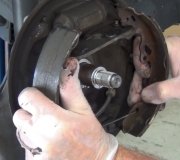First of all, check the level in the reservoir. Low fluid level will turn the same light on. Also be sure the parking pedal is fully retracted.
The next thing to suspect is unequal pressures in the two hydraulic systems, typically caused by leak. GM has used some unusual master cylinder designs that include a valve that blocks fluid flow to a leak. Due to changes in the suspension geometry you may not notice a brake pull, or you might just see a tiny wiggle in the steering wheel when you apply the brakes. The easiest thing to do is drive over sand or granite at a slow speed and try to lock all four wheels. See if just the front skid, just the rear, or only one front wheel.
Front-wheel-drive cars use split-diagonal hydraulic systems where one front wheel and the opposite rear wheel are on the same circuit. On GM cars those have that valve that blocks fluid flow. A leak will trip the valve but so will anything else that causes unequal pressures. Most commonly that is pedal-bleeding with a helper. No pressure will build up in the circuit with the bleeder screw open but it will in the other side. That will trip that valve and block fluid flow to two wheels, and you likely will not notice anything wrong in the pedal feel. By the sounds of your description they may be using the same master cylinder design on your car. That's why I'd like you to try to lock up the wheels and make them skid.
Those valves can also trip just by replacing the front brake pads. You have to push the pistons back into the calipers to make room for the new thicker pads, then you have to pump the brake pedal to work the pistons back out after everything is reassembled. First of all it is important to never push the brake pedal more than halfway to the floor. Doing so is likely to damage it if it is more than about a year old. That will also prevent tripping that valve. When the pistons start to move out, one will contact the pads first and start to build pressure before the other side will, and that's when that valve will trip.
Now that I covered all that, I've never seen that valve or a split-diagonal hydraulic system on a rear-wheel-drive car. The last thing to consider is did you bench-bleed the new master cylinder before you installed it? If you did not there is most likely air still in the system. Since the master cylinder sits at quite an angle, the air will stick around the ports in the steel lines. It won't go all the way down to the wheels during normal braking, and it usually will not wash back into the reservoir when you release the brakes because of that high angle. What you can do is loosen one of the steel lines a little, then have a helper slowly push the brake pedal. It should take about 20 seconds to push it half way to the floor. If there's air in the lines you'll see the bubbles come out past the threads of the line nuts. Be sure to tighten the nut before you tell the helper he can release the pedal. If some air bubbles came out, do that a second time, then do the other line the same way.
Wednesday, May 1st, 2013 AT 2:29 AM



